Potrebujeme váš súhlas na využitie jednotlivých dát, aby sa vám okrem iného mohli ukazovať informácie týkajúce sa vašich záujmov. Súhlas udelíte kliknutím na tlačidlo „OK“.
ASTM F2852-10
Standard Practice for Training a Land Search Tracker
Automaticky preložený názov:
Štandardné praktiky pre výcvik Land vyhľadávanie Tracker
NORMA vydaná dňa 1.12.2010
Informácie o norme:
Označenie normy: ASTM F2852-10
Poznámka: NEPLATNÁ
Dátum vydania normy: 1.12.2010
Kód tovaru: NS-54625
Počet strán: 4
Približná hmotnosť: 12 g (0.03 libier)
Krajina: Americká technická norma
Kategória: Technické normy ASTM
Kategórie - podobné normy:
Anotácia textu normy ASTM F2852-10 :
Keywords:
ICS Number Code 03.100.30 (Management of human resources), 13.200 (Accident and disaster control)
Doplňujúce informácie
| Significance and Use | ||||||||
|
This guide establishes the minimum standard for training a Tracker as it relates to general, field, and tracking-specific knowledge and skills. A person trained to this guide, who demonstrates the knowledge and skills required, may be recognized as a Tracker. A Tracker shall be adequately trained in the environment in which he or she is expected to work. Nothing in this guide precludes a response organization or the Authority Having Jurisdiction from adding additional requirements for its own members. Being trained as a Tracker is not an indication that a person possesses adequate field skills or knowledge to make mission critical decisions. This guide is not a complete training or performance document. It is only an outline of the topics required for training or evaluating a Tracker. It may, however, be used in the development of, or as part of, a complete training document or program. This guide does not stand alone and must be used with the referenced documents (1-19), qualifying tracking training materials, and appropriate field training, under the supervision of a qualified trainer, to provide the specific skills and knowledge needed by a Tracker. Though this guide establishes a basic training standard, it does not imply that a Tracker is a “trainee,” “probationary,” or other similar team member designation of an organization. It is up to the Authority Having Jurisdiction or response organization to determine the requirements and qualifications for member designations. Because tracking could be performed in a dangerous area and Trackers may be required to perform rigorous activities in adverse conditions, safety and fitness standards shall be included in a response organization’s policies and procedures. Trackers shall determine if the task can be completed safely with the personnel, equipment, and training at hand. This guide may be used in conjunction with other appropriate materials to evaluate training documents to determine if their content meets the necessary topics for training or performance of a Tracker. Likewise, this guide may be used to evaluate an existing training program to see if it meets the requirements of this guide. The requirements presented in the following sections are not presented in any particular order and do not represent a training sequence. A comprehensive Tracker training program shall include an evaluation process to determine the students’ ability to meet these training standards. Written and oral examinations designed to evaluate knowledge of theory, policy, and the practices required by the response organization, which include the requirements of this guide, may be utilized. However, field or training ground exercises and demonstrations are necessary to determine practical tracking knowledge or a developed skill. |
||||||||
| 1. Scope | ||||||||
|
1.1 This guide establishes a standard of training to address specific skills required for a searcher who participates as a Tracker in support of a land search effort. 1.1.1 This guide establishes a standard of knowledge for a Tracker as related to general, field, and tracking-specific knowledge and skills. 1.1.2 This guide identifies the performance requirements of a Tracker who performs tracking of humans as it relates primarily to land search events, but might include law enforcement investigation or military situations. 1.2 A Tracker is required to have the knowledge and skill sets pertaining to basic tracking techniques and be familiar with unique tracking terminology and the equipment commonly used. 1.3 A Tracker may be utilized in any of three common tracking environment kinds described in Classification F1993: Kind A (wilderness), Kind B (urban), Kind C (mountainous) or other kinds. 1.4 This guide does not purport to address all of the safety concerns, if any, associated with its use. It is the responsibility of the user of this guide to establish appropriate safety and health practices and determine the applicability of regulatory requirements prior to use. |
||||||||
| 2. Referenced Documents | ||||||||
|
Podobné normy:
Historická
1.5.2007
Historická
1.5.2014
Historická
1.7.2013
Historická
15.7.2013
Historická
1.10.2014
Historická
1.11.2011


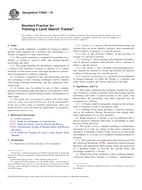
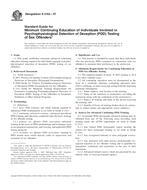 ASTM E2162-07
ASTM E2162-07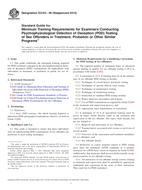 ASTM E2163-06(2014)..
ASTM E2163-06(2014)..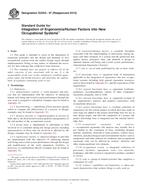 ASTM E2350-07(2013)..
ASTM E2350-07(2013)..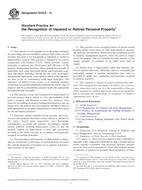 ASTM E2378-13
ASTM E2378-13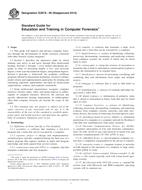 ASTM E2678-09(2014)..
ASTM E2678-09(2014)..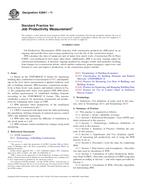 ASTM E2691-11
ASTM E2691-11
 Cookies
Cookies
